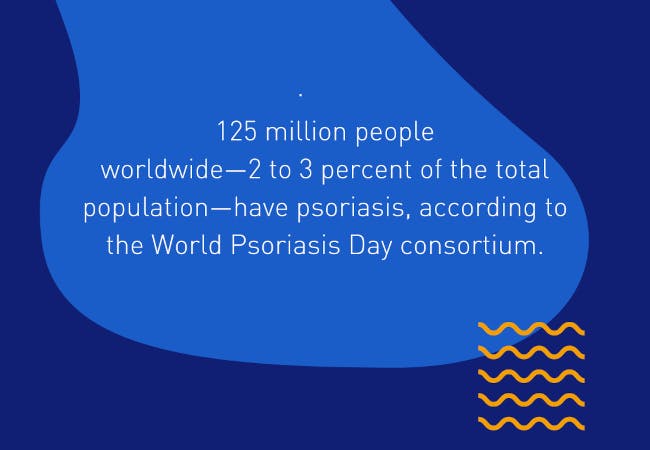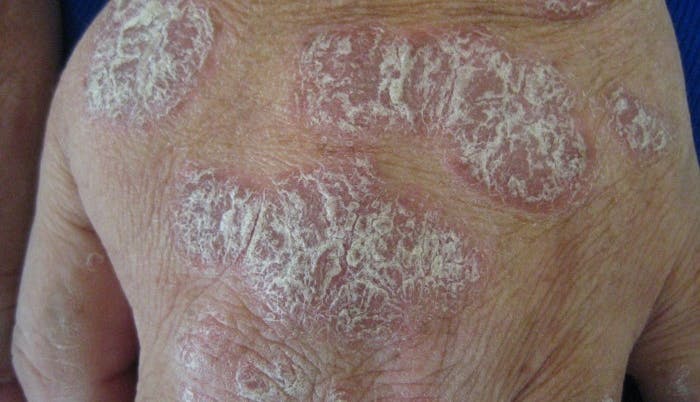Psoriasis Statistics
Millions of people in the U.S. and around the world experience psoriasis and psoriatic arthritis, and there is no cure, yet.

Psoriasis by the Numbers
Prevalence
- According to current studies, more than 8 million Americans have psoriasis. [1]
- 125 million people worldwide — 2 to 3 percent of the total population — have psoriasis, according to the World Psoriasis Day consortium.
- An estimated 30 percent of people with psoriasis also develop psoriatic arthritis. [2]
- Psoriasis prevalence in African Americans is 1.5 percent compared to 3.6 percent of Caucasians. [1]
- Psoriasis is likely to be underdiagnosed among African-Americans and other individuals with skin of color due to differences in clinical presentation. [3]
Quality of Life
- Psoriasis is not a cosmetic problem. Nearly 60 percent of people with psoriasis reported their disease to be a large problem in their everyday life. [4]
- Nearly 40 percent with psoriatic arthritis reported their disease to be a large problem in everyday life. [5]
- Patients with moderate to severe psoriasis experienced a greater negative impact on their quality of life. [6]
- Psoriasis has a greater impact on the quality of life in women and younger patients. [6]
- Individuals with psoriasis experience higher rates of many comorbidities, including cardiovascular disease, heart attack [7], stroke [8], metabolic syndrome [9], and depression [10], among others.
Age of Onset
- Psoriasis can appear at any age, but often has two peaks of onset. The first is between 20 – 30 years of age and the second between 50 – 60 years of age. [11]
- Psoriatic arthritis usually develops between the ages of 30 and 50, but can develop at any age.
Severity
- The National Psoriasis Foundation defines mild psoriasis as affecting less than 3 percent of the body; 3 percent to 10 percent is considered moderate; more than 10 percent is considered severe. For most individuals, your hand is about the same as 1 percent of the skin surface.
- However, the severity of psoriasis is also measured by how psoriasis affects a person's quality of life. Nearly one-quarter of people with psoriasis have cases that are considered moderate to severe. [12]
Cost
- Patients with psoriasis incur annual health care costs that are significantly greater than those of the general population and may amount to $135 billion annually (2013, U.S. $). [13]
- In the United States, the economic burden of psoriasis is substantial because this disease results in considerable negative physical, psychiatric, and social consequences. [13]
References
[1] Armstrong AW, Mehta MD, Schupp CW, Gondo GC, Bell SJ, Griffiths CEM. Psoriasis Prevalence in Adults in the United States. JAMA Dermatol. Published online June 30, 2021. doi:10.1001/jamadermatol.2021.2007
[2] Mease PJ, Gladman DD, Papp KA, et al. Prevalence of rheumatologist-diagnosed psoriatic arthritis in patients with psoriasis in European/North American dermatology clinics. Journal of the American Academy of Dermatology. 2013;69(5):729-735.
[3] Alexis AF, Blackcloud P. Psoriasis in skin of color: epidemiology, genetics, clinical presentation, and treatment nuances. J Clin Aesthet Dermatol. 2014;7(11):16-24.
[4] Stern RS, Nijsten T, Feldman SR, Margolis DJ, Rolstad T. Psoriasis is common, carries a substantial burden even when not extensive, and is associated with widespread treatment dissatisfaction. J Investig Dermatol Symp Proc. 2004;9(2):136-139.
[5] Gelfand JM, Gladman DD, Mease PJ, et al. Epidemiology of psoriatic arthritis in the population of the United States. Journal of the American Academy of Dermatology. 2005;53(4):573.
[6] Gelfand JM, Feldman SR, Stern RS, Thomas J, Rolstad T, Margolis DJ. Determinants of quality of life in patients with psoriasis: a study from the US population. Journal of the American Academy of Dermatology. 2004;51(5):704-708.
[7] Gelfand JM, Neimann AL, Shin DB, Wang X, Margolis DJ, Troxel AB. Risk of Myocardial Infarction in Patients With Psoriasis. JAMA. 2006;296(14):1735-1741.
[8] Gelfand JM, Dommasch ED, Shin DB, et al. The risk of stroke in patients with psoriasis. The Journal of investigative dermatology. 2009;129(10):2411-2418.
[9] Armstrong AW, Harskamp CT, Armstrong EJ. Psoriasis and metabolic syndrome: a systematic review and meta-analysis of observational studies. Journal of the American Academy of Dermatology. 2013;68(4):654-662.
[10] Dowlatshahi EA, Wakkee M, Arends LR, Nijsten T. The prevalence and odds of depressive symptoms and clinical depression in psoriasis patients: a systematic review and meta-analysis. The Journal of investigative dermatology. 2014;134(6):1542-1551.
[11] Armstrong AW. Psoriasis. JAMA dermatology. 2017;153(9):956-956.
[12] Helmick CG, Lee-Han H, Hirsch SC, Baird TL, Bartlett CL. Prevalence of psoriasis among adults in the U.S.: 2003-2006 and 2009-2010 National Health and Nutrition Examination Surveys. American journal of preventive medicine. 2014;47(1):37-45.
[13] Brezinski EA, Dhillon JS, Armstrong AW. Economic Burden of Psoriasis in the United States: A Systematic Review. JAMA dermatology. 2015;151(6):651-658.
[14] Mercy K, Kwasny M, Cordoro KM, et al. Clinical manifestations of pediatric psoriasis: results of a multicenter study in the United States. Pediatric dermatology. 2013;30(4):424-428.
[15] Burden-Teh E, Thomas KS, Ratib S, Grindlay D, Adaji E, Murphy R. The epidemiology of childhood psoriasis: a scoping review. The British journal of dermatology. 2016;174(6):1242-1257.
Last updated on 12/21/2022 by the National Psoriasis Foundation.
.png?ixlib=gatsbyFP&auto=compress%2Cformat&fit=max&rect=12%2C0%2C1175%2C675&w=778&h=447)

